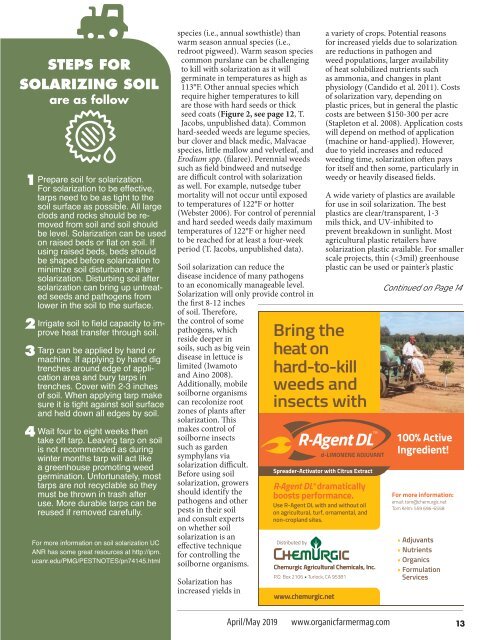OrganicFarmer_AprMayFinal_e
You also want an ePaper? Increase the reach of your titles
YUMPU automatically turns print PDFs into web optimized ePapers that Google loves.
STEPS FOR<br />
SOLARIZING SOIL<br />
are as follow<br />
1<br />
2<br />
3<br />
4<br />
Prepare soil for solarization.<br />
For solarization to be effective,<br />
tarps need to be as tight to the<br />
soil surface as possible. All large<br />
clods and rocks should be removed<br />
from soil and soil should<br />
be level. Solarization can be used<br />
on raised beds or flat on soil. If<br />
using raised beds, beds should<br />
be shaped before solarization to<br />
minimize soil disturbance after<br />
solarization. Disturbing soil after<br />
solarization can bring up untreated<br />
seeds and pathogens from<br />
lower in the soil to the surface.<br />
Irrigate soil to field capacity to improve<br />
heat transfer through soil.<br />
Tarp can be applied by hand or<br />
machine. If applying by hand dig<br />
trenches around edge of application<br />
area and bury tarps in<br />
trenches. Cover with 2-3 inches<br />
of soil. When applying tarp make<br />
sure it is tight against soil surface<br />
and held down all edges by soil.<br />
Wait four to eight weeks then<br />
take off tarp. Leaving tarp on soil<br />
is not recommended as during<br />
winter months tarp will act like<br />
a greenhouse promoting weed<br />
germination. Unfortunately, most<br />
tarps are not recyclable so they<br />
must be thrown in trash after<br />
use. More durable tarps can be<br />
reused if removed carefully.<br />
For more information on soil solarization UC<br />
ANR has some great resources at http://ipm.<br />
ucanr.edu/PMG/PESTNOTES/pn74145.html<br />
species (i.e., annual sowthistle) than<br />
warm season annual species (i.e.,<br />
redroot pigweed). Warm season species<br />
common purslane can be challenging<br />
to kill with solarization as it will<br />
germinate in temperatures as high as<br />
113°F. Other annual species which<br />
require higher temperatures to kill<br />
are those with hard seeds or thick<br />
seed coats (Figure 2, see page 12, T.<br />
Jacobs, unpublished data). Common<br />
hard-seeded weeds are legume species,<br />
bur clover and black medic, Malvacae<br />
species, little mallow and velvetleaf, and<br />
Erodium spp. (filaree). Perennial weeds<br />
such as field bindweed and nutsedge<br />
are difficult control with solarization<br />
as well. For example, nutsedge tuber<br />
mortality will not occur until exposed<br />
to temperatures of 122°F or hotter<br />
(Webster 2006). For control of perennial<br />
and hard seeded weeds daily maximum<br />
temperatures of 122°F or higher need<br />
to be reached for at least a four-week<br />
period (T. Jacobs, unpublished data).<br />
Soil solarization can reduce the<br />
disease incidence of many pathogens<br />
to an economically manageable level.<br />
Solarization will only provide control in<br />
the first 8-12 inches<br />
of soil. Therefore,<br />
the control of some<br />
pathogens, which<br />
reside deeper in<br />
soils, such as big vein<br />
disease in lettuce is<br />
limited (Iwamoto<br />
and Aino 2008).<br />
Additionally, mobile<br />
soilborne organisms<br />
can recolonize root<br />
zones of plants after<br />
solarization. This<br />
makes control of<br />
soilborne insects<br />
such as garden<br />
symphylans via<br />
solarization difficult.<br />
Before using soil<br />
solarization, growers<br />
should identify the<br />
pathogens and other<br />
pests in their soil<br />
and consult experts<br />
on whether soil<br />
solarization is an<br />
effective technique<br />
for controlling the<br />
soilborne organisms.<br />
Solarization has<br />
increased yields in<br />
Bring the<br />
heat on<br />
hard-to-kill<br />
weeds and<br />
insects with<br />
Distributed by<br />
a variety of crops. Potential reasons<br />
for increased yields due to solarization<br />
are reductions in pathogen and<br />
weed populations, larger availability<br />
of heat solubilized nutrients such<br />
as ammonia, and changes in plant<br />
physiology (Candido et al. 2011). Costs<br />
of solarization vary, depending on<br />
plastic prices, but in general the plastic<br />
costs are between $150-300 per acre<br />
(Stapleton et al. 2008). Application costs<br />
will depend on method of application<br />
(machine or hand-applied). However,<br />
due to yield increases and reduced<br />
weeding time, solarization often pays<br />
for itself and then some, particularly in<br />
weedy or heavily diseased fields.<br />
A wide variety of plastics are available<br />
for use in soil solarization. The best<br />
plastics are clear/transparent, 1-3<br />
mils thick, and UV-inhibited to<br />
prevent breakdown in sunlight. Most<br />
agricultural plastic retailers have<br />
solarization plastic available. For smaller<br />
scale projects, thin (


















